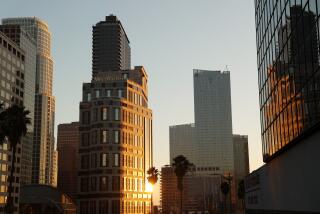Recovery Doing a Job at the Office
Just a few years ago, suggesting construction of an office building in the San Fernando Valley would have gotten a developer laughed right out of his banker’s office. Today, the number crunchers might actually take a hard look at the project as local vacancy rates approach historic lows. A recent survey by the real estate brokerage Grubb & Ellis found the Valley to have the lowest office vacancy rate in Southern California--another of many encouraging signs that the area’s economy continues to climb out of the devastating slump of the early 1990s.
With this kind of demand, it won’t be long before the bottom line of new office construction looks attractive enough for builders to start dusting off the bulldozers. Already, commercial and retail construction is picking up in spots like the former General Motors plant in Panorama City. But it’s useful to pause before too much gets built and consider what kind of development would work best for the Valley of tomorrow. Old models may no longer work as well as they have in the past because the economic data suggest that the Valley emerges from recession at a different place--one where entrepreneurial individuals and firms play a larger role as the influence of giant paternal corporations dwindles.
Nowhere is that phenomenon more evident than in the East Valley, where hundreds of tiny start-up companies have formed lucrative orbits around the major film studios. For instance, even as Burbank officials try to find new tenants for land once held by aerospace giant Lockheed-Martin, which pulled up stakes in 1990, the city enjoys a vacancy rate in high-end office space approaching 1% and some of the highest lease rates in Los Angeles County. Many of these new businesses are moving into traditional office space, but just as many one- and two-person shops are looking for smaller, more flexible space.
It’s unlikely that the Valley will witness the kind of explosive growth that changed its landscape so drastically in the 1980s. Raw land is almost gone and homeowners associations burned by bad projects now monitor the process closely. That kind of check is positive, and potential developers should study the lessons of the 1980s carefully so that construction reflects both the needs and the limits of the Valley.
For instance, both scale and character are critical. Because so much of the Valley’s commercial districts abut neighborhoods of single-family homes, building giant corporate-style monoliths does little but guarantee a costly fight with neighbors and a rough ride through the city’s approval process. Good projects require talking. Most residents don’t oppose development. They oppose bad or inconsistent development. For years, residents in Encino fought an office tower at the corner of Hayvenhurst Avenue and Ventura Boulevard. But when a developer finally asked what the neighborhood wanted--and listened--the project was finished in no time.
After seven years of dormancy, the prospects for new construction in the Valley appear bright. But developers, residents and city officials must work together to ensure that development is the benefit it should be rather than the blemish it too often has been.
More to Read
Inside the business of entertainment
The Wide Shot brings you news, analysis and insights on everything from streaming wars to production — and what it all means for the future.
You may occasionally receive promotional content from the Los Angeles Times.










